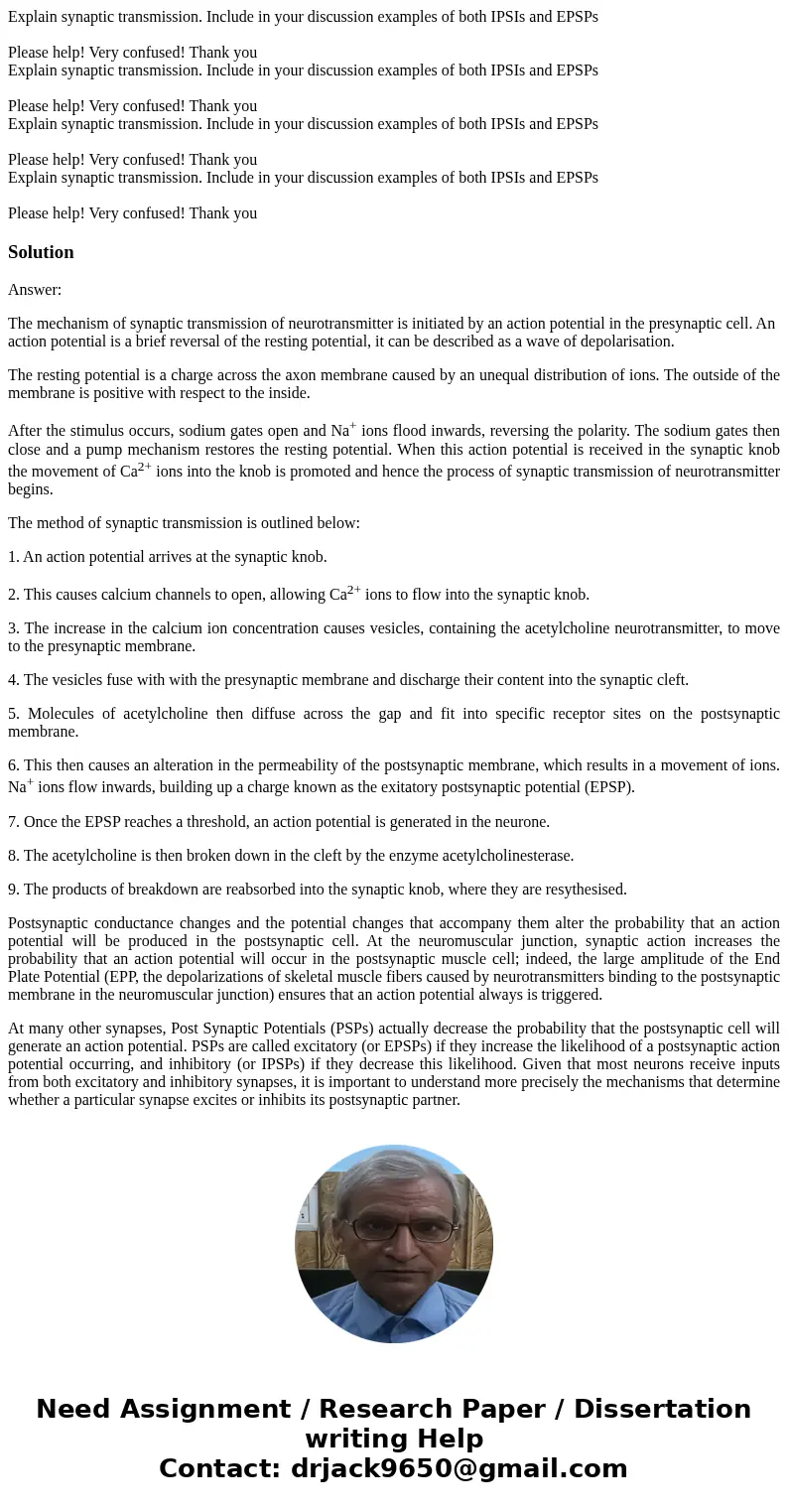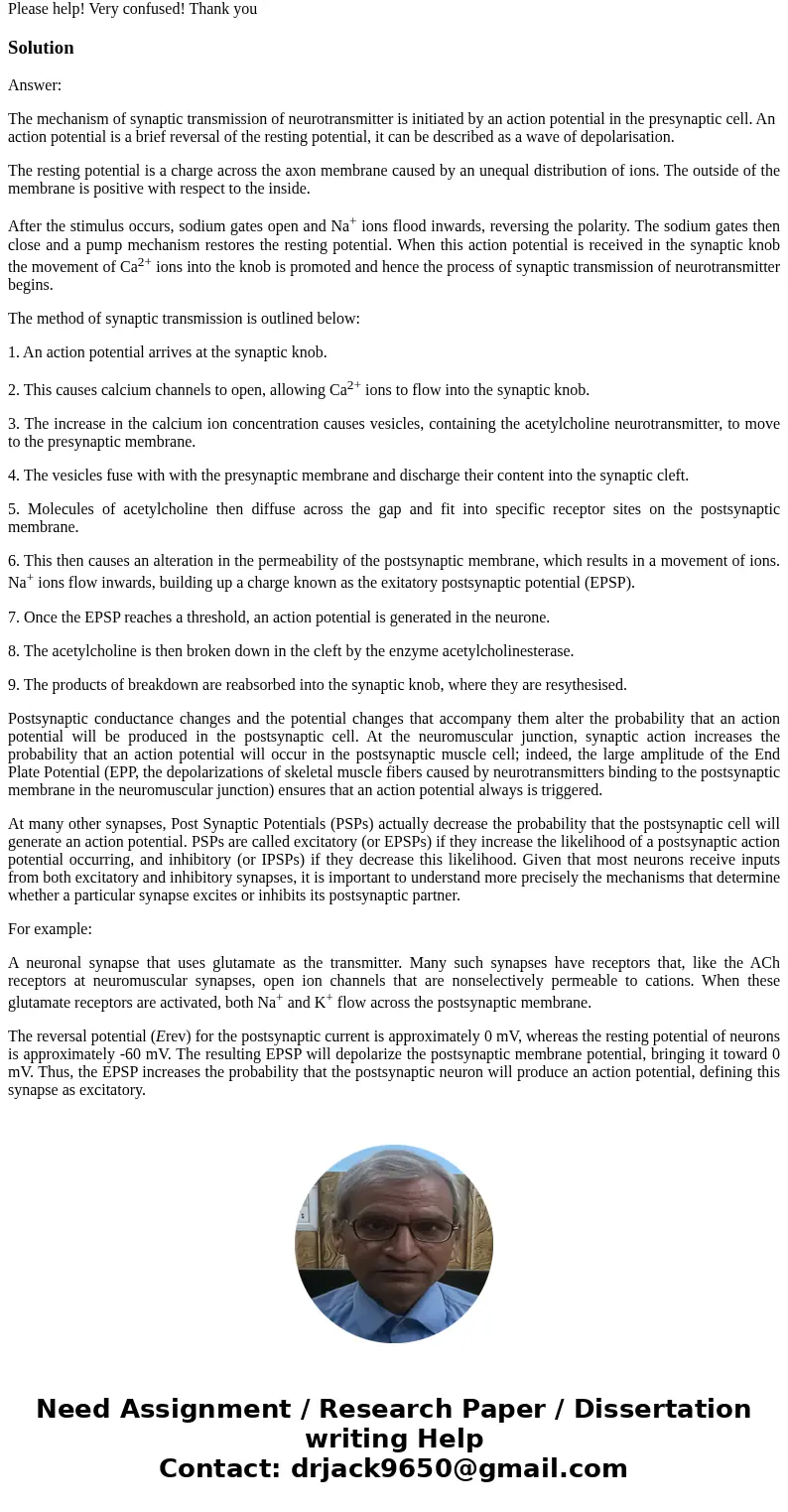Explain synaptic transmission Include in your discussion exa
Solution
Answer:
The mechanism of synaptic transmission of neurotransmitter is initiated by an action potential in the presynaptic cell. An action potential is a brief reversal of the resting potential, it can be described as a wave of depolarisation.
The resting potential is a charge across the axon membrane caused by an unequal distribution of ions. The outside of the membrane is positive with respect to the inside.
After the stimulus occurs, sodium gates open and Na+ ions flood inwards, reversing the polarity. The sodium gates then close and a pump mechanism restores the resting potential. When this action potential is received in the synaptic knob the movement of Ca2+ ions into the knob is promoted and hence the process of synaptic transmission of neurotransmitter begins.
The method of synaptic transmission is outlined below:
1. An action potential arrives at the synaptic knob.
2. This causes calcium channels to open, allowing Ca2+ ions to flow into the synaptic knob.
3. The increase in the calcium ion concentration causes vesicles, containing the acetylcholine neurotransmitter, to move to the presynaptic membrane.
4. The vesicles fuse with with the presynaptic membrane and discharge their content into the synaptic cleft.
5. Molecules of acetylcholine then diffuse across the gap and fit into specific receptor sites on the postsynaptic membrane.
6. This then causes an alteration in the permeability of the postsynaptic membrane, which results in a movement of ions. Na+ ions flow inwards, building up a charge known as the exitatory postsynaptic potential (EPSP).
7. Once the EPSP reaches a threshold, an action potential is generated in the neurone.
8. The acetylcholine is then broken down in the cleft by the enzyme acetylcholinesterase.
9. The products of breakdown are reabsorbed into the synaptic knob, where they are resythesised.
Postsynaptic conductance changes and the potential changes that accompany them alter the probability that an action potential will be produced in the postsynaptic cell. At the neuromuscular junction, synaptic action increases the probability that an action potential will occur in the postsynaptic muscle cell; indeed, the large amplitude of the End Plate Potential (EPP, the depolarizations of skeletal muscle fibers caused by neurotransmitters binding to the postsynaptic membrane in the neuromuscular junction) ensures that an action potential always is triggered.
At many other synapses, Post Synaptic Potentials (PSPs) actually decrease the probability that the postsynaptic cell will generate an action potential. PSPs are called excitatory (or EPSPs) if they increase the likelihood of a postsynaptic action potential occurring, and inhibitory (or IPSPs) if they decrease this likelihood. Given that most neurons receive inputs from both excitatory and inhibitory synapses, it is important to understand more precisely the mechanisms that determine whether a particular synapse excites or inhibits its postsynaptic partner.
For example:
A neuronal synapse that uses glutamate as the transmitter. Many such synapses have receptors that, like the ACh receptors at neuromuscular synapses, open ion channels that are nonselectively permeable to cations. When these glutamate receptors are activated, both Na+ and K+ flow across the postsynaptic membrane.
The reversal potential (Erev) for the postsynaptic current is approximately 0 mV, whereas the resting potential of neurons is approximately -60 mV. The resulting EPSP will depolarize the postsynaptic membrane potential, bringing it toward 0 mV. Thus, the EPSP increases the probability that the postsynaptic neuron will produce an action potential, defining this synapse as excitatory.


 Homework Sourse
Homework Sourse